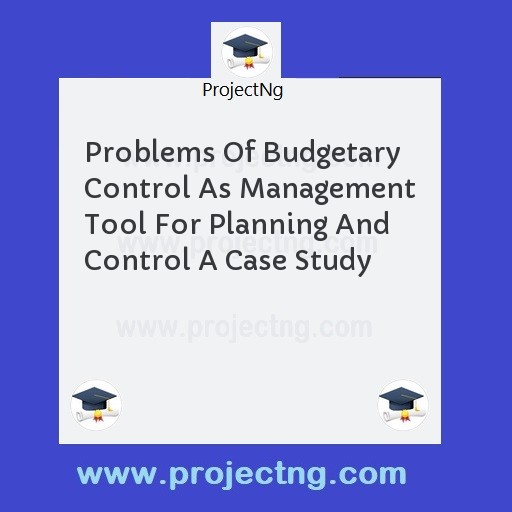Problems Of Budgetary Control As Management Tool For Planning And Control A Case Study
Banking And Finance Project Topics
Get the Complete Project Materials Now! »
PROBLEMS OF BUDGETARY CONTROL AS MANAGEMENT TOOL FOR PLANNING AND CONTROL A CASE STUDY
ABSTRACT
The research on problem of budgetary control as a management tool for planning and control. Its source is mainly concentrated at Asaba capital city of Delta as a result of the lack o implementation of budget and management of budget in he financial industries and organizations. The objective is to identify the cause of poor performance in an organization also to examine the problem of inadequate allocation of resources to meet organizational goals, standard for prediction of past and present budget for future reference. The researcher examines this work by using primary and secondary data, personal interviews and questionnaire, the yaro yemen’s formula (n=N/ 1+n (e)2) was used. In the chapter four, the data was analysed by percentage and the findings were properly discussed. From the findings, he researcher observed that forecasting should be used in predicting the future budget, also lack of management of fund causes inadequate allocation of resources and equal relationship exist within the organization in conclusion. The research recommended that there should be equal relationship within an organization and forecasting should be used in prediction of future budget and finally, management auditors should be called in from time to time to make enquiry in reducing the stress and constrain involved in effective management.
TABLE OF CONTENTS
Cover page
Title page
Approval page........................................................................................i
Dedication ............................................................................................ii
Acknowledgement...............................................................................iii
Abstract................................................................................................iv
Table of contents...................................................................................v
CHAPTER ONE:
1.0 Introduction ................................................................................1
1.1 Background of the study ............................................................1
1.2 Statement of problem..................................................................4
1.3 Purpose of the study....................................................................5
1.4 Research questions......................................................................5
1.5 Significance of the study............................................................6
1.6 Scope of the study.......................................................................7
1.7 Definition of terms......................................................................8
CHAPTER TWO
2.0 Literature Review ....................................................................11
2.1 General Concepts Genesis of Budget ......................................11
2.2 Models and Theories Relevant to the Research Question........13
2.2.1 Meaning of Budget...................................................................13
2.2.2 Classification of budget............................................................14
2.2.3 Method of budget......................................................................17
2.2.4 Manner of budget preparation .................................................19
2.2.5 Preparation of a typical budget.................................................21
2.3 Current Literatures Relevant to the research questions ...........23
2.4 Summary of Literature review..................................................25
CHAPTER THREE:
Research methodology .............................................................27
3.0 Introduction ..............................................................................27
3.1 Research designed. ..................................................................27
3.2 Area of the study.......................................................................28
3.3 Population of the study.............................................................28
3.4 Sampling techniques.................................................................29
3.5 Source of data collection .........................................................30
3.6 Instrument for data collection ..................................................31
3.7 Reliability and validity of the instrument.................................32
3.8 Distribution and Retrieval of the instrument for data collection ............32
3.9 Method of data analysis............................................................32
CHAPTER FOUR:
Data presentation and analysis of Data ..............................................34
4.1 Introduction ..............................................................................34
4.2 Analysis of data........................................................................37
4.3 Findings....................................................................................41
4.4 Discussion of findings .............................................................43
CHAPTER FIVE:
Summary of findings, conclusions and Recommendation
5.1 Summary of findings. ..............................................................44
5.2 Research conclusions................................................................46
5.3 Recommendation .....................................................................47
5.4 Limitations of the study...........................................................48
5.5 Suggestions for further research...............................................49
References................................................................................51
Appendix A ..............................................................................53
Questionnaire ...........................................................................54
CHAPTER ONE
1.0 INTRODUCTION
1.1 BACKGROUND OF THE STUDY:
Fundamentally, management is the coordination of human effort that is art of accomplishment of goods by utilizing the effort of other people. The management process may be varied as the total management effort operating in a particular endeavor that include decision making, the application of selected techniques and producers and the motivation of individual and groups to accomplish specified objective. One of the most important approaches that have been developed for facilitating effective performance of management process is budget and budgetary control. As consequence, the concept has found wide acceptance in recent years in the better managed companies / organizations. A budget, according to Horgen et al (2013:59), as a qualitative expression of a plan of action and, an aid to coordination and implementation.
Every organization has an implicit and explicit objective, it hopes to achieve in a given period of time such objective is translated into plan through the formulation of policies and selections of programmes in other to check derivation from it, hence most organization normally use budget as an action plan, a budget is therefore a parameter, which measures actual achievement, Budgetary control as sample used to institute control for the plan, this is because budgetary control takes target of desired performance as its standard than systematically collected information relating to actual performance and identifies variance between targets and actual performance. Budgetary control is more than an administrative technique which aims to ensure the managerial function are in fact carried out a well organized and coordinated fashion hence budgetary control apart from being a longer system which involves setting objectives concerning alternative programmes and incorporating them into the formulating authorization and implementation of budget, accounting per and reviewing of findings to check deviation from actual plan in order for corrective measures to be taken on time.
Budget which is required to achieve different aims within an organization starts with the setting out of the objective of the organization by the management for the budgeted year according to government fiscal and monetary policies, guidelines and the approval of the management centered in carrying out the plans which are contained in each budget.
In conclusion, for management to provide adequate control over the budget of an organization, it could coordinate all the collaborated responsible parties in achieving the actual result with the budget to establish the variance, hence budget is therefore a primary tools for planning while the process of budgetary control is both planning and control device.
Be the First to Share On Social

Enjoying our content?
Don't miss out on new videos! Subscribe to our YouTube channel for more awesome content.
Subscribe Now!













